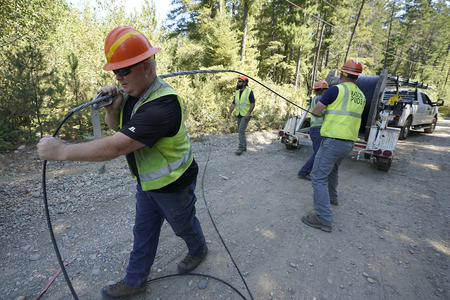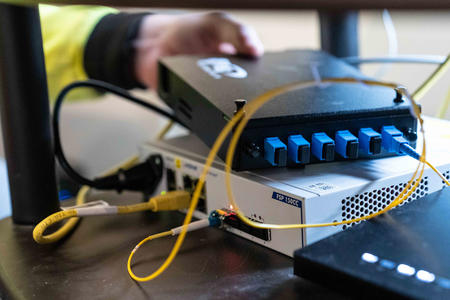The 2021 infrastructure bill has provided states with a once-in-a-generation chance to put billions of dollars into wiring up the nation’s most remote corners. That money is poised to fund massive buildouts by telecom companies large and small, as well as ports, public utility districts and public/private partnerships.
Mark Vasconi, the director of Washington’s four-and-a-half year-old State Broadband Office, will retire next month as the office prepares to direct $1.2 billion in federal funding toward network expansion projects that aim to reach some 260,000 unserved households statewide. The office must first finalize major decisions about what entities will be eligible for the funds, how to rank applications and how to ensure the long-term viability of the new networks by a federal deadline of Dec. 27.

Under Washington’s current draft proposal, applications will be scored on a 100-point system, with the strongest consideration given to applicants that can self-finance more than the minimum 25% of the project cost. Affordability will be another significant factor, with preference given to applicants that commit to charging future customers less than $75 a month. Other factors include fair labor practices, construction timelines and commitments from multiple retailers to offer service over new networks.
Largely de-emphasized in the draft rubric are letters of community support and consultation with local and tribal governments. In an email to Crosscut, Vasconi wrote that the office is reviewing public comments and scoring could change, but did not directly address criticisms from some commenters that community support was weighted too low.
Some advocates have argued that connecting hard-to-reach communities will require treating broadband as an essential public good similar to electricity – and empowering port districts and public utility districts to serve households directly. State agencies have responded to these calls in part by reforming a controversial process that disqualified grant applications from public utilities based on objections from large telecommunications companies like Comcast and CenturyLink.
This story is a part of Crosscut’s WA Recovery Watch, an investigative project tracking federal dollars in Washington state.
Currently just one public provider, Jefferson County PUD, has announced plans to utilize a 2021 law change to serve consumers over its own network. After winning more than $50 million in grants for a major expansion, it plans to begin connecting households in rural Quilcene, near Olympic National Park, in February.
One of the first major challenges facing Vasconi’s successor will be shoring up the federal government’s spotty connectivity data – a task that will ultimately fall to local governments, nonprofits and tribes. Vasconi said an outreach effort last year identified some 67,000 locations statewide inaccurately listed as already having reliable internet service. That map data, whether it’s correct or not, will largely determine what areas qualify for federal funds and what areas get excluded.
As 2024 nears — the target date lawmakers previously set for connecting every Washington household — Crosscut asked Vasconi about why so many communities remain in the digital dark, the historic opportunity facing us now and how we can avoid repeating past mistakes. This interview has been edited for length and clarity.
Crosscut: Washington is about to receive $1.2 billion through the Broadband Equity Access Deployment (BEAD) program, maybe the most ambitious effort ever by Congress to address the digital divide. What do you think will be the biggest challenges or barriers to expanding broadband access in the next few years?
Vasconi: There’s going to be challenges with respect to supply chain, workforce, and there’s also a big challenge with respect to the amount of funding, as much as it is. So stretching that funding in ways, augmenting that funding with match support from particular applicants is going to be really important. Because without that, even though we are going to have $1.2 billion from the federal government and a state match, it wouldn’t surprise me to see the total cost necessary to provide internet for all in the state to be somewhere in the neighborhood of $2.2 or 2.5 billion. It’s also going to be a challenge because, given the costs that we see for an all-fiber network, we’re going to have to make some choices with respect to which locations are going to get fiber – and hopefully most will – but there are going to be some locations where we are going to have to use alternative technologies.
You’re talking about things like satellite or wireless?
I think principally fixed wireless, but I can certainly see in particular areas of the state where even fixed wireless is going to be cost-prohibitive. It may need to be some sort of lower orbiting satellite service to fill in those hardest-to-reach areas of the state.
As in many states, Washington’s plan relies on broadband service data from the Federal Communications Commission to determine what areas will be eligible to get connected and what areas get shut out. For many years, critics have said the FCC’s maps are inaccurate and that the agency has failed to hold large companies accountable for following through on previous taxpayer-funded buildouts. Do you agree with those criticisms and do you think current federal leadership is doing enough to ensure that BEAD does not succumb to these same flaws?
I agree with the assessment with regard to previous efforts. Clearly, original mapping efforts were wholly deficient. The most recent [mapping] effort that the FCC has gone through has been a big improvement over what we had historically seen. The challenge is, as you can well imagine, you’re trying to identify the service potential of every serviceable location in America. That’s probably somewhere in the neighborhood of, I don’t know, 100 million locations. It’s huge. So it’s always going to be difficult to do that down to a level that doesn’t have controversy. We will be engaging in a further challenge process within the state as required by NTIA [National Telecommunications and Information Administration] to try and make this mapping effort more accurate. We hope at the end of that challenge process we’re going to have a map that is more accurate and probably as accurate as it can be given the timeframe.
You mentioned the role of states in overseeing accountability for those buildouts. I’m curious if there are lessons for officials at the state level as they implement BEAD?
You want an organization that is somewhat close to the ground to make those kinds of auditing decisions, but that would need to be supported by funding and headcount to be able to do that. At a minimum it requires that recipients of funding provide frequent updates. In an ideal world it would be good to have a group of auditors who could go out and actually see, OK you’ve reported X, have you done X? And some of that may necessarily fall in the realm of the federal government because these are federal dollars. So you’ve got some jurisdictional issues that would probably need to be worked out. Would Congress effectively allow NTIA to deputize state broadband offices to conduct audits? I don’t know. That’s not currently written in BEAD. Currently it would be GAO [the federal Government Accountability Office] that would do the audits.
How do you think the public should measure the success of this massive investment of BEAD money?
Did unserved and underserved citizens, households and businesses in the state receive service due to this funding? And that’s a longer-term evaluation because once awards are granted, you’re looking at a five-year process. That scorecard will be accumulating over time, but you really won’t know until you’re able to look back to see. Certainly timing is important. You would want this to happen as quickly as possible, but it’s going to take a while to build out these systems.
When the State Broadband Office was created in 2019, legislators set a goal of universal broadband internet access by 2024. With the benefit of hindsight, that seems to have been overly optimistic. What do you think legislators have learned in that time?
I think it’s hard to speak for legislators, frankly, because you’re going to have lots of different opinions.
Sure. I guess I’m curious from your perspective as someone who has been steeped in this for a long time; it seems to me that only recently has the state taken a leading role on broadband issues. Is that fair to say?
I think Washington has led in many respects on broadband issues for a while, but that leadership needs to be married up with funding. And I think that the funding has really come in many regards because of the pandemic. The American Rescue Plan Act funding that just our office has distributed is in the neighborhood of about $270 million, but that’s only happened in really the last 18 months. I think one of the lessons here is that these projects take time, more time than maybe would have otherwise been assumed when you get into this stuff, and the cost of it. This is expensive infrastructure to get to those communities that are not served — which is a proper place for that funding to go. It is essential for that funding to go there, but it takes time, and it’s even more money than I think anybody could have imagined.
The Department of Commerce, which houses the State Broadband Office, selected Deputy Director Erika Henry to take over on an interim basis beginning in the new year, according to a recent news release. Gov. Jay Inslee’s office said they have launched a search for a new permanent director.
You can read the draft proposal Washington has submitted to the NTIA here. Volume I concerns the process by which local governments, nonprofits and tribes can challenge the FCC’s broadband service maps. Washington has proposed that challenges will be accepted for a window of 30 days, tentatively set to begin on April 8. Volume II concerns eligibility requirements and a rubric for how the office will score applications.






